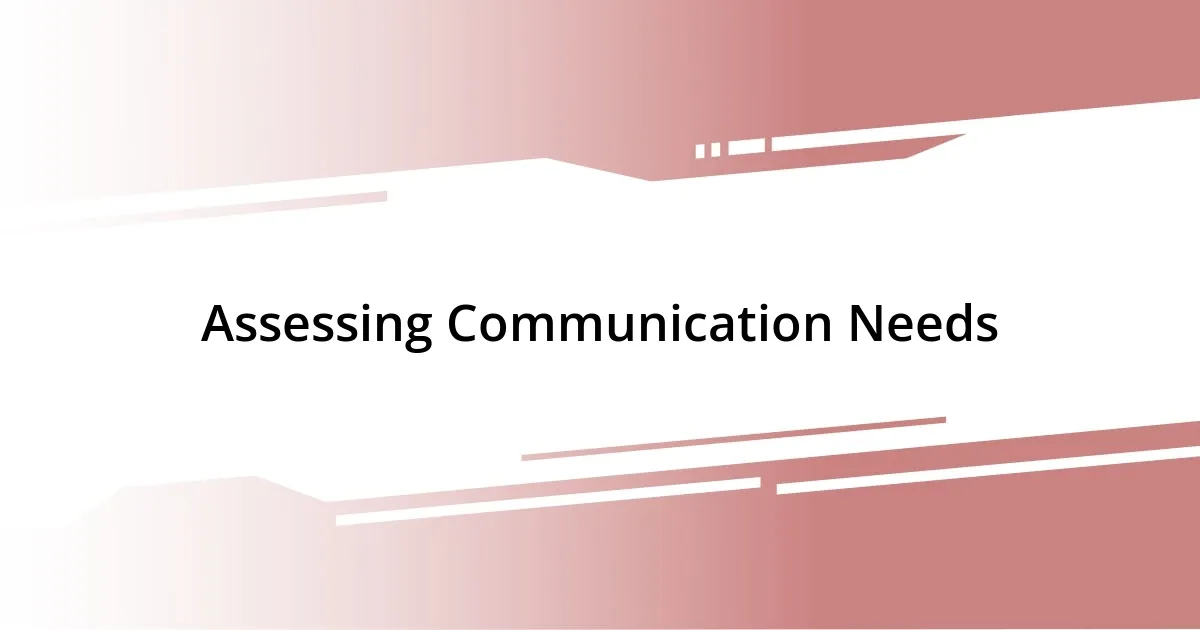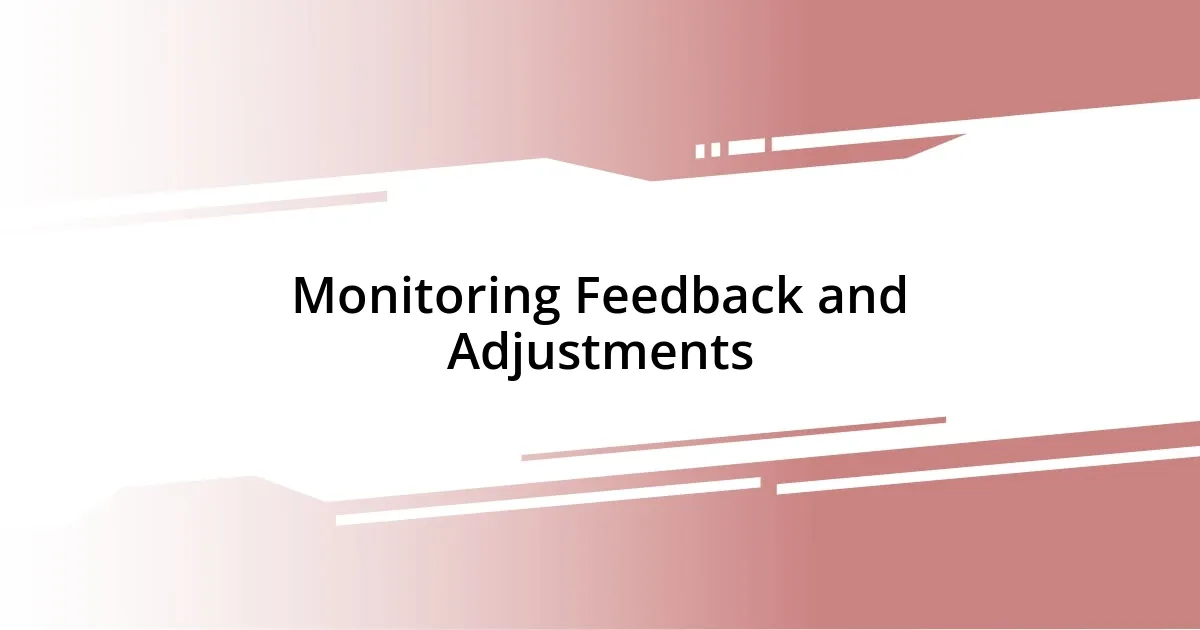Key takeaways:
- Effective risk communication requires understanding the audience’s emotional responses and tailoring messages to resonate with their personal experiences.
- Identifying and engaging key stakeholders enhances communication strategies and fosters broader understanding within diverse community segments.
- Continuous assessment of communication needs, using feedback mechanisms, allows for real-time adjustments and improves overall effectiveness.
- Building trust through transparency and shared experiences creates a more engaged and open dialogue with the audience.

Understanding Risk Communication
Risk communication is the art of delivering complex information in a way that resonates with people, ensuring they not only understand the risks but also feel empowered to act. I remember once attending a community meeting about a potential health hazard; the officials used jargon that left many feeling confused and anxious. How would that help anyone make informed choices?
It’s fascinating how our emotions influence our perception of risk. I once had a friend who was terrified of flying, despite knowing that statistically, it’s one of the safest forms of travel. Her fear often stemmed from sensational news stories rather than facts. How often do we allow emotions to cloud our judgment about risks in our daily lives? Understanding the balance between emotional reactions and factual information is key to effective risk communication.
Effective risk communication should also consider the audience’s perspective and background. I recall a workshop where participants shared their experiences with environmental issues. Listening to their stories illuminated how personal experiences shape our understanding of risk. Isn’t it important to acknowledge these individual narratives when crafting messages about risks? Doing so creates a connection that enhances comprehension and encourages proactive engagement.

Identifying Key Stakeholders
Identifying key stakeholders is a crucial part of risk communication. From my experience, understanding who your stakeholders are can significantly shape your communication strategy. During a project I worked on, we conducted a stakeholder mapping exercise that made a difference in how we approached our messaging. We identified not just the primary stakeholders, like local authorities, but also community members, activists, and even industry representatives. The diversity in perspectives helped us craft messages that resonated across different audience segments.
Here are some essential groups to consider when identifying stakeholders:
- Community members: Their on-the-ground experiences provide invaluable insights.
- Local government officials: They play a key role in policy implementation and public trust.
- Healthcare professionals: Expertise in health-related risks is crucial for accurate communication.
- Environmental organizations: They can influence public opinion and mobilize community action.
- Media representatives: They help to disseminate information widely and shape public discourse.
Engaging these stakeholders early can ensure your communication is relevant and impactful. I’ve found that collaboration often leads to richer conversations and more effective outreach.

Assessing Communication Needs
Assessing communication needs is a vital step in developing an effective risk communication strategy. In my experience, understanding the audience’s baseline knowledge is key. I remember a project where we surveyed community members to gauge their previous experiences and concerns about a local environmental issue. Their responses not only highlighted misunderstandings but also revealed fears that we had not anticipated. Recognizing these gaps helped us tailor our communication to address specific misunderstandings, making it much more effective.
Taking it a step further, I often reflect on the importance of language and cultural context. I once facilitated a meeting where participants spoke different languages and came from varied backgrounds. Using plain language and visual aids proved essential in breaking down complex concepts. It’s amazing how accessibility in communication can foster inclusivity. Isn’t it empowering when everyone feels they can contribute to important discussions?
Finally, I’ve found that assessing communication needs isn’t a one-time task. It’s about ongoing evaluation. In my previous role, we established feedback loops after our campaigns. Gathering insights from the audience helped us adjust our messaging in real-time. Adapting continuously based on the audience’s response can significantly enhance the effectiveness of risk communication. This iterative process is something that I believe every communicator should embrace.
| Assessment Method | Description |
|---|---|
| Surveys | Gauge baseline knowledge and identify specific concerns. |
| Focus Groups | Facilitate in-depth discussions for qualitative insights. |
| Feedback Mechanisms | Gather ongoing responses to improve messaging. |

Crafting Clear Messages
When crafting clear messages for risk communication, I’ve found that simplicity is key. Once, during a community health initiative, I realized that using jargon not only confused people but also alienated them. By switching to everyday language and breaking down information into bite-sized pieces, I noticed a marked increase in engagement and understanding. Isn’t it fascinating how a word can make or break communication?
Clarity also involves visual elements. I remember designing infographics for a campaign on environmental risks. The visuals helped transform complex data into something digestible and relatable, allowing people to visualize their concerns. It’s interesting how a well-placed image can evoke emotion and drive home a message. Have you ever thought about how powerful visuals can enhance understanding in communication?
Finally, repetition is an important strategy I often lean on. In past outreach efforts, I would echo key messages across different platforms. This not only reinforced the information but also helped to combat misinformation. I always asked myself, “How can I make this message stick?” This approach not only solidified understanding but also built trust—they knew they could rely on consistent information. In risk communication, consistency can be just as critical as clarity.

Selecting Effective Channels
Selecting the right channels for risk communication is crucial for reaching your audience effectively. I recall a time when we opted for a combination of social media and community meetings for disseminating information about a public health issue. While social media allowed us to reach a broader audience quickly, the face-to-face meetings provided an invaluable space for dialogue and community trust. It made me realize how diverse channels can complement each other in amplifying messages.
In my experience, it’s essential to consider where your audience spends their time. For instance, I managed a campaign aimed at high school students and quickly learned that platforms like Instagram and TikTok were far more effective than traditional emails. By meeting them where they naturally gather, we fostered engagement and sparked genuine interest. Have you ever paused to think about how channel choice can shape your message’s impact?
Moreover, it’s not just about selecting channels, but also about tailoring messages to fit each one. When I shifted our communication strategy to adapt our messaging style for different platforms, the response was incredible. For example, quick, playful posts on social media contrasted with more detailed reports sent via email, and this dual approach not only catered to different preferences but also kept audiences engaged across the spectrum. It’s amazing how minor adjustments in channel selection and message design can create significant ripples in understanding and awareness.

Monitoring Feedback and Adjustments
Monitoring feedback is an integral part of my strategy for effective risk communication. I remember a specific project on flood preparedness where we actively sought input from the community after each outreach session. The feedback we received shaped our future messages, allowing us to address the concerns that resonated most with the audience. Isn’t it interesting how listening transforms a one-way message into a two-way conversation?
Adjustments based on feedback are essential, and I’ve seen incredible outcomes when I take this to heart. In one instance, after realizing that our messaging was too technical for a farming community, I consulted local leaders to refine our language. This shift made a significant difference, fostering a greater sense of trust and connection. Have you ever considered the impact of involving stakeholders in the communication process?
I also employ analytics to monitor sentiment and reactions through social media platforms. In a recent campaign about vaccination, I tracked engagement metrics and comments closely, adapting our language to dismantle misconceptions as they emerged. This proactive approach not only mitigated confusion but also encouraged a culture of open dialogue. Have you thought about how quickly evolving sentiments can guide your next steps in communication?

Building Trust and Engagement
When it comes to building trust and engagement, I’ve learned that transparency is key. In one project, I shared not only the successes but also the challenges we faced along the way. This openness created a space where community members felt comfortable expressing their concerns, and I found that vulnerability can really deepen connections. Have you ever tried being candid about your own struggles? It’s surprising how much people appreciate an authentic approach.
Another critical aspect I’ve observed is the power of shared experiences. I once facilitated a workshop where participants could share their own stories related to the risk we were addressing. Hearing personal anecdotes from others created an atmosphere of empathy and understanding. It struck me how these moments of connection fostered trust, as participants knew they weren’t alone in their worries. Have you seen how storytelling can transform a conversation?
Engaging your audience also means being responsive. During a recent campaign on mental health awareness, I made it a point to reply to comments and messages promptly. It wasn’t just about answering questions; it was about showing that I valued their input. Each interaction reinforced the relationship and encouraged more people to join the conversation. Have you considered how such simple gestures can elevate trust within your community?














